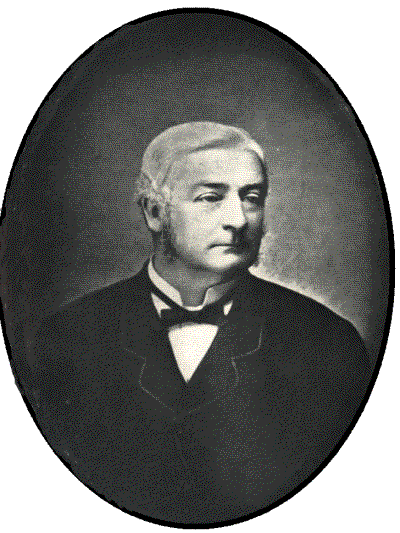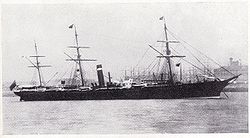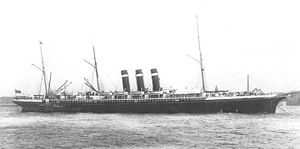
Inman Line
Encyclopedia

American Line
The American Line was a shipping company based in Philadelphia that was founded in 1871. It began as part of the Pennsylvania Railroad, although the railroad got out of the shipping business soon after founding the company...
, was one of the three largest 19th century British passenger shipping
Shipping
Shipping has multiple meanings. It can be a physical process of transporting commodities and merchandise goods and cargo, by land, air, and sea. It also can describe the movement of objects by ship.Land or "ground" shipping can be by train or by truck...
companies on the North Atlantic, along with the White Star Line
White Star Line
The Oceanic Steam Navigation Company or White Star Line of Boston Packets, more commonly known as the White Star Line, was a prominent British shipping company, today most famous for its ill-fated vessel, the RMS Titanic, and the World War I loss of Titanics sister ship Britannic...
and Cunard Line
Cunard Line
Cunard Line is a British-American owned shipping company based at Carnival House in Southampton, England and operated by Carnival UK. It has been a leading operator of passenger ships on the North Atlantic for over a century...
. The firm's formal name for much of its history was the Liverpool, Philadelphia and New York Steamship Company, but it was also variously known as the Liverpool and Philadelphia Steamship Company, as Inman Steamship Company, Limited, and, for the last few years before absorption into the American Line, as the Inman and International Steamship Company.
By embracing new technology, the Inman Line was the first to show that unsubsidized ocean liners could profitably operate on the North Atlantic. With its first steamer, the of 1850, Inman led the drive to replace wood-hulled paddle steamer
Paddle steamer
A paddle steamer is a steamship or riverboat, powered by a steam engine, using paddle wheels to propel it through the water. In antiquity, Paddle wheelers followed the development of poles, oars and sails, where the first uses were wheelers driven by animals or humans...
s with iron-hulled ships equipped with screw propulsion. In 1852, Inman also established that steerage passengers could be transported in steamships. Inman's of 1866 was the first screw liner that could match the speed of the paddlers. By 1870, Inman landed more passengers in New York than any other line. In 1886, the American-owned International Navigation Company
International Navigation Company
The International Navigation Company was a Philadelphia based holding company owning 26 ships totaling 181,000 tons and carried more passengers than either Cunard or White Star, when the company was reorganized as International Mercantile Marine in 1902...
purchased the Inman line and started renewal of the express fleet with two Blue Riband
Blue Riband
The Blue Riband is an unofficial accolade given to the passenger liner crossing the Atlantic Ocean in regular service with the record highest speed. The term was borrowed from horse racing and was not widely used until after 1910. Under the unwritten rules, the record is based on average speed...
winners, the and the second , ushering in the double screw era that ended the need for auxiliary sails.
1850–1866

John Grubb Richardson
John Grubb Richardson was a major Irish industrialist who founded the model village of Bessbrook near Newry, in what is now Northern Ireland...
and his brothers along with their young business partner, William Inman
William Inman
William Inman was the owner of the Liverpool, New York and Philadelphia Steamship Company, also known as the Inman Line, which ran services from Liverpool to New York & Philadelphia, in the United States, for emigration in the mid-19th century.He was the owner of Upton Manor, in the grounds of...
(1825 - 1881). In 1850, Inman persuaded his partners to form the Liverpool and Philadelphia Steamship Company and buy an advanced new ship, the . She proved profitable because her iron hull required less repair, and her screw propulsion system left more room for passengers and freight. City of Glasgows moderate speed considerably reduced coal consumption. The ship's first voyage for her new owners departed for Philadelphia on 17 December 1850. The next year, she was joined by a larger edition, the .
In 1852, the Inman broke new ground by transporting steerage
Steerage
Steerage is the act of steering a ship. "Steerage" also refers to the lowest decks of a ship.-Steerage and steerage way:The rudder of a vessel can only steer the ship when water is passing over it...
passengers under steam. As Irish Quakers, the Richardsons were concerned about the poor conditions experienced by immigrants traveling to America. Until then, immigrants traveled by sailing ship with unpredictable passage times. Steerage passengers were required to bring their own food, and often ran short. In 1836, Diamond lost 17 of her 180 steerage passengers to starvation when the ship required 100 days to make the crossing. From the beginning, Inman provided better steerage quarters and adopted the recommendation of a Parliamentary Committee to provide cooked meals to immigrants. As a result, Inman was able to charge steerage rates of 8 guinea
Guinea (British coin)
The guinea is a coin that was minted in the Kingdom of England and later in the Kingdom of Great Britain and the United Kingdom between 1663 and 1813...
s, while the fastest sailing packets charged 4 to 6 guineas. During the period, Inman liners typically carried 500 passengers, 80% in steerage.
Disaster struck the new firm in 1854 when the company lost both the with all hands and the brand new , albeit with no loss of life. The remaining liner, the was chartered to the French Government for the Crimean War
Crimean War
The Crimean War was a conflict fought between the Russian Empire and an alliance of the French Empire, the British Empire, the Ottoman Empire, and the Kingdom of Sardinia. The war was part of a long-running contest between the major European powers for influence over territories of the declining...
along with three additional liners that were completed or purchased in 1855. The Richardsons withdrew from the firm because of its involvement with the war. William Inman then assumed complete control.
At the end of the conflict, Inman resumed service to Philadelphia. However, New York was now the primary gateway to the west, and Inman decided to alternate between the two ports. The firm's name was changed to the Liverpool, Philadelphia and New York Steam Ship Company, but all ships were routed to New York after the line's SS Kangaroo was trapped by ice in the Delaware River
Delaware River
The Delaware River is a major river on the Atlantic coast of the United States.A Dutch expedition led by Henry Hudson in 1609 first mapped the river. The river was christened the South River in the New Netherland colony that followed, in contrast to the North River, as the Hudson River was then...
. Until 1857 the firm ran a fortnightly service from Liverpool. That same year, following the collapse of the Collins Line
Collins Line
The Collins Line is the common name for the American shipping company started by Israel Collins and then built up by his son Edward Knight Collins...
, Inman took its place carrying the U.S. Mails. In 1859, a call at Queenstown
Cobh
Cobh is a seaport town on the south coast of County Cork, Ireland. Cobh is on the south side of Great Island in Cork Harbour. Facing the town are Spike Island and Haulbowline Island...
was added to pick up Irish immigrants. The next year, Inman ran a weekly service, increasing in 1863 to three sailings every fortnight, and twice a week during summer in 1866.
1866–1887

Royal Mail Ship
Royal Mail Ship , usually seen in its abbreviated form RMS, a designation which dates back to 1840, is the ship prefix used for seagoing vessels that carry mail under contract by Royal Mail...
was transferred from the Admirality to the Post Office and opened for bid. Inman was awarded one of the three weekly New York mail services and the fortnightly route to Halifax, Nova Scotia formerly held by Cunard. While Cunard continued to receive a subsidy, Inman was paid sea postage. However, two years later Inman's New York contract was extended for seven years at an annual subsidy of 35,000 pounds as compared to Cunard's subsidy of £70,000 for two weekly New York mail sailings. In 1870, Inman landed 44,100 passengers in New York, compared to Cunard's 24,500, although Cunard still carried substantially more first class passengers. Throughout the 1870s, Inman's passage times were shorter than Cunard's. The of 1869 beat Scotias eastbound record and in 1875 the won the Blue Riband
Blue Riband
The Blue Riband is an unofficial accolade given to the passenger liner crossing the Atlantic Ocean in regular service with the record highest speed. The term was borrowed from horse racing and was not widely used until after 1910. Under the unwritten rules, the record is based on average speed...
by taking the westbound record.

RMS Oceanic (1870)
RMS Oceanic was the White Star Line's first liner and an important turning point in passenger liner design.-Design and construction:Oceanic was built by Harland and Wolff in Belfast, and was launched on 27 August 1870, arriving in Liverpool for her maiden voyage on 26 February 1871...
and her sisters. The new White Star record breakers were especially economical because of their use of compound engines. Oceanic consumed only 58 tons of coal per day, compared to 110 tons for City of Brussels. White Star also set new standards for comfort by placing the dining saloon midships and doubling the size of cabins. With its fleet now rendered out of date, Inman quickly brought its express liners back to the ship yards for compound engines and other changes to match the new White Star liners while Cunard lagged behind.
The Panic of 1873
Panic of 1873
The Panic of 1873 triggered a severe international economic depression in both Europe and the United States that lasted until 1879, and even longer in some countries. The depression was known as the Great Depression until the 1930s, but is now known as the Long Depression...
started a five year shipping depression that strained Inman's finances as well as its rivals. To raise additional capital, the partnership was restructured in 1875 as a stock company and renamed the Inman Steamship Company, Limited. The next year, Inman and White Star agreed to coordinate their sailings to reduce competition. When the 1869 mail contracts expired, the British Post Office ended both Cunard and Inman's subsidies and paid on the basis of weight, but at a rate substantially higher than paid by the U.S Post Office. Cunard's weekly New York mail sailings were reduced to one and White Star was awarded the third mail sailing. Every Tuesday, Thursday and Saturday, a liner from one of the three firms departed Liverpool with the mail for New York. Inman reduced its fleet so that only the express liners remained.
However, profits still dropped in face of other new competitors seeking the Blue Riband such as the National Line and the Guion Line
Guion Line
The Liverpool and Great Western Steamship Company, known commonly as the Guion Line, was a British passenger service that operated the Liverpool-Queenstown-New York route from 1866 to 1894. While incorporated in Great Britain, 52% of the company's capital was from the American firm, Williams and...
, along with numerous steamship concerns from the continent competing for the immigrant trade. To restore its fortunes, Inman ordered the , which was designed as the largest and fastest liner yet. Unfortunately, the ship failed to meet her design specifications and was rejected in 1882 after only six voyages.
William Inman died before the ship's maiden voyage and the company suffered without his leadership. In 1883, City of Brussels was lost in the Mersey
Mersey
Mersey may refer to:* River Mersey, in northwest England* Mersea Island, off the coast of Essex in England * Mersey River in the Australian state* Electoral division of Mersey in the state of Tasmania, Australian...
after colliding with another steamer. Meanwhile, Cunard renewed its mail fleet with four exceptional steel-hulled liners. Needing capital to match its rivals, Inman directors agreed to voluntary liquidation so that the largest creditor, the Philadelphia-based International Navigation Company
International Navigation Company
The International Navigation Company was a Philadelphia based holding company owning 26 ships totaling 181,000 tons and carried more passengers than either Cunard or White Star, when the company was reorganized as International Mercantile Marine in 1902...
could purchase Inman's assets.
Closing chapter
The line was reorganized as the Inman and International Steamship Company, and its new owners provided the capital to build two outstanding record breakers, the twin-screw and . However, the British government responded to the ownership change by revoking Inman's mail contract. After considerable lobbying, the U.S. Congress agreed to replace the contract and allow Inman to register its two new record breakers in the U.S. if International Navigation built two similar express liners in American yards. Therefore, on February 22, 1893 the American flag was broken out over the two newest Inman vessels and the company merged into the American LineAmerican Line
The American Line was a shipping company based in Philadelphia that was founded in 1871. It began as part of the Pennsylvania Railroad, although the railroad got out of the shipping business soon after founding the company...
.
Fleet
The Inman fleet—all of which built for Inman unless otherwise indicated—consisted of the following ships, presented in order of acquisition. List sourced from| Ship | Built | In service for Inman | Type | Tonnage | Notes |
|---|---|---|---|---|---|
| 1850 | 1850-1854 | iron-screw | 1,600 GRT | missing 1854, no survivors | |
| 1851 | 1851-1871 | iron-screw | 1,900 GRT | sold and converted to sail 1871 | |
| 1854 | 1854-1854 | iron-screw | 2,100 GRT | wrecked, no loss of life | |
| 1855 | 1855-1874 | iron-screw | 2,400 GRT | sold | |
| 1855 | 1855-1873 | iron-screw | 2,400 GRT | wrecked 1873 | |
| 1854 | 1855-1869 | iron-screw | 1,850 GRT | built for other owners, sold 1869 | |
| 1856 | 1858-1861 | iron-screw | 1,600 GRT | built for other owners, sold to US Government 1861 | |
| 1851 | 1859-1865 | iron-screw | 1,950 GRT | built for other owners, lost 1865 | |
| 1855 | 1859-1868 | iron-screw | 2,200 GRT | built for other owners, sold 1868 | |
| 1856 | 1860-1875 | iron-screw | 2,200 GRT | built for Cunard, sold 1875 | |
| 1861 | 1861-1864 | iron-screw | 2,550 GRT | wrecked 1864 | |
| 1863 | 1863-1878 | iron-screw | 2,550 GRT | sold 1878 | |
| 1863 | 1863-1871 | iron-screw | 1,550 GRT | sold 1871 | |
| 1863 | 1863-1879 | iron-screw | 1,550 GRT | built for other owners, sold 1879 | |
| 1864 | 1864-1873 | iron-screw | 2,000 GRT | sold 1874 to Dominion Line | |
| 1865 | 1865-1870 | iron-screw | 2,200 GRT | missing 1870, no survivors | |
| 1865 | 1865-1881 | iron-screw | 2,650 GRT | sold 1881 | |
| 1866 | 1866-1884 | iron-screw | 2,650 GRT | sold 1884 | |
| 1867 | 1867-1879 | iron-screw | 2,400 GRT | sold 1879 | |
| 1889 | 1867-1878 | iron-screw | 2,950 GRT | sold 1878 to Dominion Line | |
| 1869 | 1869-1883 | iron-screw | 3,100 GRT | Eastbound record holder, sunk 1883, 10 lost | |
| 1872 | 1872-1887 | iron-screw | 4,450 GRT | burned at sea 1887, no loss of life | |
| 1873 | 1873-1893 | iron-screw | 4,800 GRT | express liner, joined American Line 1893 | |
| 1873 | 1873-1891 | iron-screw | 4,800 GRT | express liner, sold 1891 | |
| 1875 | 1875-1893 | iron-screw | 5,500 GRT | Blue Riband Blue Riband The Blue Riband is an unofficial accolade given to the passenger liner crossing the Atlantic Ocean in regular service with the record highest speed. The term was borrowed from horse racing and was not widely used until after 1910. Under the unwritten rules, the record is based on average speed... winner, joined American Line 1893 |
|
| 1881 | 1881-1881 | iron-screw | 8,400 GRT | returned to builder after 6 voyages, sold to Anchor Line | |
| 1883 | 1883-1892 | steel-screw | 5,150 GRT | built for other owners, wrecked 1892, no loss of life | |
| 1871 | 1885-1886 | iron-screw | 3,850 GRT | chartered from White Star | |
| 1888 | 1888-1893 | steel, twin screw | 10,650 GRT | Blue Riband Blue Riband The Blue Riband is an unofficial accolade given to the passenger liner crossing the Atlantic Ocean in regular service with the record highest speed. The term was borrowed from horse racing and was not widely used until after 1910. Under the unwritten rules, the record is based on average speed... winner, joined American Line 1893 |
|
| City of Paris | 1889 | 1889-1893 | steel, twin screw | 10,650 GRT | Blue Riband Blue Riband The Blue Riband is an unofficial accolade given to the passenger liner crossing the Atlantic Ocean in regular service with the record highest speed. The term was borrowed from horse racing and was not widely used until after 1910. Under the unwritten rules, the record is based on average speed... winner, joined American Line 1893 |

